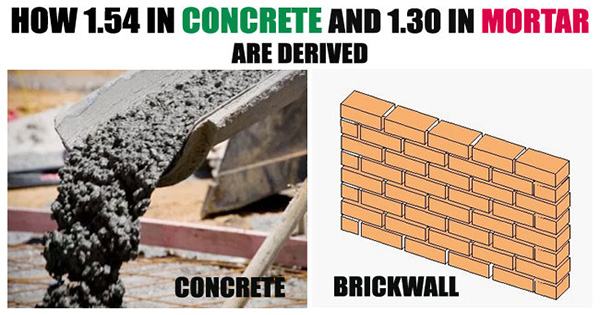How 1.54 in concrete and 1.30 in mortar are derived

In this civil engineering article, detail explanation is given on what is 1.54 in concrete and 1.30 in mortar.
1.54 in concrete
Whenever we get the volume of any material, normally it is always a wet volume. When water is added in dry mixture and this wet mixture is arranged in shuttering, the particles reorganize themselves and fill the pores and voids between them which in turn decrease the volume of wet mixture.
Given below, the void ratio compressibility of aggregate, sand and cement:-
Aggregate
33 to 34% (33 to 34% of voids is filled after being wet or compressed)
Sand
20% (20% of voids is filled)
Cement
Inconsiderable because of fine particles.
After summing up, we get = 34% + 20% = 54%
Volume of Cube or Wet Volume of Cube = 1m x 1m x 1m = 1m3.
It is known that Dry Volume always remains in excess of Wet Volume i.e. ( Vdry > Vwet )
Normally,
Dry Volumn of Concrete = Roughly 54 % to 57 % in excess of Wet Volume Concrete.
= Wet Volume + (54% of Wet Volume or 57% of Wet Volume)
= 1m3 + (54/100) x 1m3 or 1m3 + (57/100) x 1m3
= (1+0.54) m3 or (1+0.57) m3
= 1.54 m3 or 1.57 m3
Therefore, based on the factor of safety that varies from 1.54 to 1.57 to check that shrinkage, volume of dry concrete = 1.54 to 1.57 times Volume of wet concrete.
1.30 in mortar
Mortar is formed with cement and sand.
Void ratio compressibility.
Sand – 20%.
Cement – Inconsiderable because of fine particles.
So, dry volume remains 20% greater than wet volume.
Dry volume > 20% of wet volume
= 1 + .20 = 1.20
Normally, the site engineers consider 5 to 10% extra for wastage occurs in the site by labors.
So, 1.20 + .1 = 1.30
Dry volume = 1.30 x wet volume

